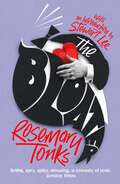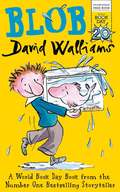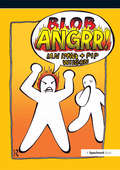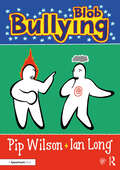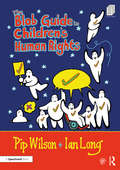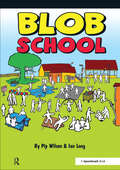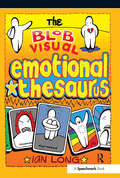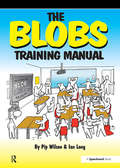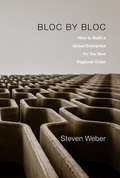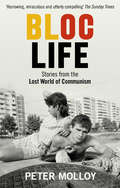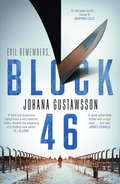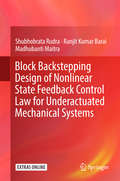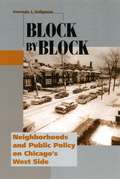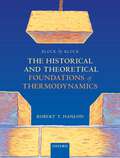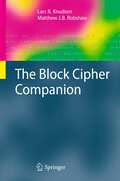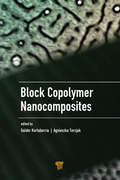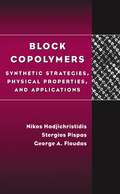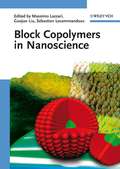- Table View
- List View
The Bloater: The brilliantly original rediscovered classic comedy of manners
by Rosemary TonksWITH A NEW INTRODUCTION BY STEWART LEE'Should The Bloater be republished? Oh God, absolutely, it's fantastic' Stewart LeeMin works at the BBC as an audio engineer, where she is struggling to replicate the sound of a heartbeat. At home, other matters of the heart are making a mockery of life as Min knows it.Min has found herself the object of her lodger's affection. An internationally renowned opera singer she's nicknamed 'The Bloater', Min is disgusted and attracted to him in equal measure. But with a husband so invisible that she accidentally turns the lights off on him even when he's still in the room, Min can't quite bring herself to silence The Bloater's overtures. Vain, materialistic, yet surprisingly tender, The Bloater is a sparklingly ironic comedy of manners for all flirtatious gossips who love to hate and hate to love.PRAISE FOR THE BLOATER'A wonderfully unromantic romantic comedy' Daily Telegraph'Uncommonly good' Guardian 'It is the perfect aperitif, makes you feel warm and careless and much, much happier' The Times
Blob
by David WalliamsThis is the story of how a boy called Bob meets a blobfish fish called Blob. . . And so begins a funny and heartwarming story of a very unusual friendship - and some very strange animals. An astonishingly brilliant World Book Day Book from one of today's favourite children's authors.
The Blob Anger Book
by Pip WilsonWhen was the last time someone 'made you' angry? It's amazing just how many times in a day a situation arises that can 'cause us' to boil over. Anger management is a way to become more conscious of how we react to a situation which triggers us to become angry. Identifying these trigger points is one way to break the pattern and preparing ourselves to change behaviour. This book includes a wide range of scenarios and situations to enable identification of feelings and discussions about the most appropriate way to deal with them. Subjects include: Blob Bitter; Blob Blame; Blob Humiliated; Blob Frustration; and, Blob Fight. As with every Blob tool the open approach provides an opportunity to discuss feelings and consider mechanisms for change.
Blob Bullying (Blobs)
by Pip Wilson Ian LongThis practical and accessible resource contains a wealth of discussion sheets and games to help victims of bullying reflect and talk about their experiences and feelings using the internationally familiar Blob figures. Diverse and inclusive, the Blob figures are a proven way to help children and adults share their feelings and experiences. Without age, culture or gender, they enable the individual to focus on feelings and body language. In this book, the Blobs explore bullying. From Blob Trees to Bingo games, cards and emotional scales, the Blobs provide a visual structure that allows children, teenagers and adults to open up about being bullied. Offering unique activities that help scaffold conversations for people of all ages and abilities, this is an essential resource for teachers, teaching assistants, youth and social workers, psychologists, counsellors and all those who work with and have caring responsibilities for others.
Blob Bullying (Blobs)
by Pip Wilson Ian LongThis practical and accessible resource contains a wealth of discussion sheets and games to help victims of bullying reflect and talk about their experiences and feelings using the internationally familiar Blob figures. Diverse and inclusive, the Blob figures are a proven way to help children and adults share their feelings and experiences. Without age, culture or gender, they enable the individual to focus on feelings and body language. In this book, the Blobs explore bullying. From Blob Trees to Bingo games, cards and emotional scales, the Blobs provide a visual structure that allows children, teenagers and adults to open up about being bullied. Offering unique activities that help scaffold conversations for people of all ages and abilities, this is an essential resource for teachers, teaching assistants, youth and social workers, psychologists, counsellors and all those who work with and have caring responsibilities for others.
The Blob Guide to Children’s Human Rights
by Pip Wilson Ian LongThis practical resource is designed to support children and young people as they develop an understanding of the basic rights that we are all entitled to as humans. Diverse and inclusive, Blob figures have proven themselves to be a valuable way of sparking discussion of difficult topics through the universal means of body language and feelings. Based upon the UN Convention on the Rights of the Child, this book introduces 'Blob Trees', lines and images with prompt questions and activities to help children to consider concepts such as freedom of movement and speech, safety and equality. It encourages children to think about the ways in which they can apply human rights articles to their own lives, by treating others with kindness, fairness and respect. Key features include: ‘How to use’ guides and prompt questions for each topic Simplified and child-friendly versions of all 42 human rights articles Photocopiable and downloadable worksheets designed to be used with individuals and groups of all sizes. With clear and supportive guidance and a graduated approach, this is an essential tool for teachers and practitioners looking to support an understanding of human rights in children and young people. It will also be invaluable for any groups wishing to develop accreditation for UNICEF’s ‘Rights Respecting Schools’ Awards.
The Blob Guide to Children’s Human Rights
by Pip Wilson Ian LongThis practical resource is designed to support children and young people as they develop an understanding of the basic rights that we are all entitled to as humans. Diverse and inclusive, Blob figures have proven themselves to be a valuable way of sparking discussion of difficult topics through the universal means of body language and feelings. Based upon the UN Convention on the Rights of the Child, this book introduces 'Blob Trees', lines and images with prompt questions and activities to help children to consider concepts such as freedom of movement and speech, safety and equality. It encourages children to think about the ways in which they can apply human rights articles to their own lives, by treating others with kindness, fairness and respect. Key features include: ‘How to use’ guides and prompt questions for each topic Simplified and child-friendly versions of all 42 human rights articles Photocopiable and downloadable worksheets designed to be used with individuals and groups of all sizes. With clear and supportive guidance and a graduated approach, this is an essential tool for teachers and practitioners looking to support an understanding of human rights in children and young people. It will also be invaluable for any groups wishing to develop accreditation for UNICEF’s ‘Rights Respecting Schools’ Awards.
Blob School
by Pip WilsonBlob School is an educational resource designed specifically for one of the main purchasers of the Blobs - teachers! This practical resource aims to cover all the key areas of school life so that teachers, assistants, school workers, pupils and parents can reflect upon a wide range of contexts and issues which occur throughout the school year. The book includes 47 images which can be projected upon an Interactive White Board or photocopied for whole class or small group discussion. The Blobs The Blobs are simple. They deal with deep issues using the primary languages we learn from infancy - feelings and body language. This is why they are used with children as young as 4, all the way through to the elderly. Without words, the Blobs can be interpreted in a hundred different ways. There is no right and wrong about the Blobs, which is very important. A leader who uses them in a 'one way of reading them only way' will find that the rest of their group become very frustrated in discussions. Each picture is a means to a conversation, rather than a problem to be solved or a message to be agreed upon.
Blob School (Blobs Ser.)
by Pip WilsonBlob School is an educational resource designed specifically for one of the main purchasers of the Blobs - teachers! This practical resource aims to cover all the key areas of school life so that teachers, assistants, school workers, pupils and parents can reflect upon a wide range of contexts and issues which occur throughout the school year. The book includes 47 images which can be projected upon an Interactive White Board or photocopied for whole class or small group discussion. The Blobs The Blobs are simple. They deal with deep issues using the primary languages we learn from infancy - feelings and body language. This is why they are used with children as young as 4, all the way through to the elderly. Without words, the Blobs can be interpreted in a hundred different ways. There is no right and wrong about the Blobs, which is very important. A leader who uses them in a 'one way of reading them only way' will find that the rest of their group become very frustrated in discussions. Each picture is a means to a conversation, rather than a problem to be solved or a message to be agreed upon.
The Blob Visual Emotional Thesaurus
by Ian LongThis unique visual thesaurus is designed to help writers of all ages to develop their emotional literacy. The book focuses solely upon emotions. Spanning circa 140 emotional words it is divided into three sections: ranges of emotions (offering a visual spectrum to be referred to by writers unsure of the intensity of feelings), synonyms (each image has similar images and words underneath it along with a sentence to help a new writer see how it can be embedded into a story), and antonyms - opposite pairs of feelings that are useful when wishing to create contrast in a storyline. This book will be a vital reference for every classroom and can be used individually or in whole class activities. Ian Long has worked as an artist with children, youth and adults. He has been a youth and children's worker in Gloucestershire, an artist-in-residence in Lambeth and is currently a teacher in a school in Marlborough. He is married to Jane and enjoys life with their two girls. Ian has illustrated many books for Pip.
The Blobs Training Manual: A Speechmark Practical Training Manual
by Pip Wilson Ian LongDiscover the full potential of the Blobs! Eagerly awaited, this comprehensive resource book for understanding and using Blobs provides: a fantastic insight into Blobs and Blob Trees, their development and the theory behind them; clear instructions on how Blobs can be used to discuss a wide variety of important issues, emotions or feelings; session ideas and activities for working with groups and individuals of all ages; questions to use with the Blobs; and, what not to do when using Blobs! Ideal for anyone new to the Blobs resources, this manual will also provide background information and additional ideas for those familiar with this engaging series.
Bloc by Bloc: How to Build a Global Enterprise for the New Regional Order
by Steven WeberGlobalization is taking a step backward. What, then, is the best way to organize a global enterprise? The key, Steven Weber explains, is to prepare for a world increasingly made up of competing regions with distinct rules and standards. This new condition could be more prosperous, but there will also be more friction and therefore more risk.
Bloc Life: Stories from the Lost World of Communism
by Peter MolloyThere was life before the fall.1989 was a year of astonishing and rapid change: the fall of the Berlin Wall marked the collapse of communism in Eastern Europe and an end to an entire way of life for millions of people behind the Iron Curtain. Bloc Life collects first hand testimony of the people who lived in East Germany, Czechoslovakia and Romania during the Cold War era, and reveals a rich tapestry of experience that goes beyond the headlines of spies and surveillance, secret police and political corruption. In fact, many of the people remember their lives under communism as 'perfectly ordinary' and even hanker for the 'security' that it offered.From political leaders, athletes and pop stars, to cooks, miners and cosmonauts, the stories collected in Bloc Life evoke the moods, preoccupations and experiences of a world that vanished almost overnight.
Block 46 (Roy & Castells #1)
by Johana GustawssonEvil remembers…Falkenberg, Sweden. The mutilated body of talented young jewellery designer, Linnea Blix, is found in a snow-swept marina.Hampstead Heath, London. The body of a young boy is discovered with similar wounds to Linnea's.Buchenwald Concentration Camp, 1944. In the midst of the hell of the Holocaust, Erich Hebner will do anything to see himself as a human again.Are the two murders the work of a serial killer, and how are they connected to shocking events at Buchenwald?Emily Roy, a profiler on loan to Scotland Yard from the Canadian Royal Mounted Police, joins up with Linnea's friend, French true-crime writer Alexis Castells, to investigate the puzzling case. They travel between Sweden and London, and then deep into the past, as a startling and terrifying connection comes to light.Plumbing the darkness and the horrific evidence of the nature of evil, Block 46 is a multi-layered, sweeping and evocative thriller that heralds a stunning new voice in French Noir.‘A bold and intelligent read’ Laura Wilson, Guardian‘Compelling’ Women’s Own‘Dark, oppressive and bloody but it’s also thought-provoking, compelling and very moving’ Metro‘A bold and audacious debut from a very talented writer. Heralds the beginning of a thrilling new series’ R J Ellory‘A real page-turner, I loved it’ Martina Cole’A great serial-killer thriller with a nice twist … first rate’ James Oswald‘Cleverly plotted, simply excellent’ Ragnar Jónasson
Block Backstepping Design of Nonlinear State Feedback Control Law for Underactuated Mechanical Systems
by Shubhobrata Rudra Ranjit Kumar Barai Madhubanti MaitraThis book presents a novel, generalized approach to the design of nonlinear state feedback control laws for a large class of underactuated mechanical systems based on application of the block backstepping method. The control law proposed here is robust against the effects of model uncertainty in dynamic and steady-state performance and addresses the issue of asymptotic stabilization for the class of underactuated mechanical systems. An underactuated system is defined as one for which the dimension of space spanned by the configuration vector is greater than that of the space spanned by the control variables. Control problems concerning underactuated systems currently represent an active field of research due to their broad range of applications in robotics, aerospace, and marine contexts. The book derives a generalized theory of block backstepping control design for underactuated mechanical systems, and examines several case studies that cover interesting examples of underactuated mechanical systems. The mathematical derivations are described using well-known notations and simple algebra, without the need for any special previous background in higher mathematics. The chapters are lucidly described in a systematic manner, starting with control system preliminaries and moving on to a generalized description of the block backstepping method, before turning to several case studies. Simulation and experimental results are also provided to aid in reader comprehension.
Block by Block: Neighborhoods and Public Policy on Chicago's West Side (Historical Studies of Urban America)
by Amanda I. SeligmanIn the decades following World War II, cities across the United States saw an influx of African American families into otherwise homogeneously white areas. This racial transformation of urban neighborhoods led many whites to migrate to the suburbs, producing the phenomenon commonly known as white flight. In Block by Block, Amanda I. Seligman draws on the surprisingly understudied West Side communities of Chicago to shed new light on this story of postwar urban America. Seligman's study reveals that the responses of white West Siders to racial changes occurring in their neighborhoods were both multifaceted and extensive. She shows that, despite rehabilitation efforts, deterioration in these areas began long before the color of their inhabitants changed from white to black. And ultimately, the riots that erupted on Chicago's West Side and across the country in the mid-1960s stemmed not only from the tribulations specific to blacks in urban centers but also from the legacy of accumulated neglect after decades of white occupancy. Seligman's careful and evenhanded account will be essential to understanding that the "flight" of whites to the suburbs was the eventual result of a series of responses to transformations in Chicago's physical and social landscape, occurring one block at a time.
Block by Block: The Historical and Theoretical Foundations of Thermodynamics
by Robert T. HanlonAt the heart of many fields - physics, chemistry, engineering - lies thermodynamics. While this science plays a critical role in determining the boundary between what is and is not possible in the natural world, it occurs to many as an indecipherable black box, thus making the subject a challenge to learn. Two obstacles contribute to this situation, the first being the disconnect between the fundamental theories and the underlying physics and the second being the confusing concepts and terminologies involved with the theories. While one needn't confront either of these two obstacles to successfully use thermodynamics to solve real problems, overcoming both provides access to a greater intuitive sense of the problems and more confidence, more strength, and more creativity in solving them. This book offers an original perspective on thermodynamic science and history based on the three approaches of a practicing engineer, academician, and historian. The book synthesises and gathers into one accessible volume a strategic range of foundational topics involving the atomic theory, energy, entropy, and the laws of thermodynamics.
Block chart template 1 (tactile)
by Adrian FarnsworthThis page shows a chart with five vertical blocks.
Block chart template 2 (tactile)
by Adrian FarnsworthThis page shows a chart with five horizontal blocks.
The Block Cipher Companion (Information Security and Cryptography)
by Lars R. Knudsen Matthew RobshawBlock ciphers encrypt blocks of plaintext, messages, into blocks of ciphertext under the action of a secret key, and the process of encryption is reversed by decryption which uses the same user-supplied key. Block ciphers are fundamental to modern cryptography, in fact they are the most widely used cryptographic primitive – useful in their own right, and in the construction of other cryptographic mechanisms. In this book the authors provide a technically detailed, yet readable, account of the state of the art of block cipher analysis, design, and deployment. The authors first describe the most prominent block ciphers and give insights into their design. They then consider the role of the cryptanalyst, the adversary, and provide an overview of some of the most important cryptanalytic methods. The book will be of value to graduate and senior undergraduate students of cryptography and to professionals engaged in cryptographic design. An important feature of the presentation is the authors' exhaustive bibliography of the field, each chapter closing with comprehensive supporting notes.
Block Co-polymeric Nanocarriers: Design, Concept, and Therapeutic Applications
by Neeraj Mishra Vikas PandeyThis book focuses on current advancements in the field of block copolymers and covers design, concept, and various therapeutic applications in the drug delivery. It also reviews the use of block copolymers in drug delivery applications from the development of sustained release products to smart polymeric delivery systems such as stimuli-responsive polymeric systems, for example, thermosensitive, redox-sensitive, photo-sensitive, and enzyme-sensitive. The book further discusses the nano assemblies from amphiphilic block copolymers as nanomedicine platforms for diagnosis and therapy due to their relatively small size, high drug loading capacity, controlled drug release, in vivo stability, and prolonged blood circulation. The chapters also review the various patents and ongoing clinical trials on the applications, covering several important new concepts and findings in the field of block copolymers. The book is aimed at researchers, academicians, and industrial scientists involved in the development of drug-delivery systems based on polymers.
Block Copolymer Nanocomposites
by Galder Kortaberria Agnieszka TercjakThis book provides a comprehensive overview of the synthesis and characterization of nanocomposites based on block copolymers. Because of the self-assembly capability of block copolymers for the generation of nanostructures, besides their ability to nanostructure thermosetting matrices such as epoxy and polyester, binary or ternary nanocomposites can be prepared with different nanofillers such as nanoparticles and carbon nanotubes. The book starts with a review on nanocomposites based on block copolymers and nanoparticles synthesized with the use of surfactants, followed by a review on nanocomposites with metallic nanoparticles with polymer brushes and those with carbon nanotubes. A chapter is devoted to binary systems based on block copolymers and nanoparticles synthesized by sol-gel. A review on nanocomposites based on thermosetting matrices nanostructured with block copolymers (amphiphilic or chemically modified) is also presented for both epoxy and polyester resins. The work on ternary systems based on thermosetting matrices, block copolymers, and nanoparticles is presented next. The book concludes with a discussion on nanocomposites based on epoxy and block copolymers with azobenzene groups for optical purposes.
Block Copolymer Nanocomposites
by Galder Kortaberria Agnieszka TercjakThis book provides a comprehensive overview of the synthesis and characterization of nanocomposites based on block copolymers. Because of the self-assembly capability of block copolymers for the generation of nanostructures, besides their ability to nanostructure thermosetting matrices such as epoxy and polyester, binary or ternary nanocomposites can be prepared with different nanofillers such as nanoparticles and carbon nanotubes. The book starts with a review on nanocomposites based on block copolymers and nanoparticles synthesized with the use of surfactants, followed by a review on nanocomposites with metallic nanoparticles with polymer brushes and those with carbon nanotubes. A chapter is devoted to binary systems based on block copolymers and nanoparticles synthesized by sol-gel. A review on nanocomposites based on thermosetting matrices nanostructured with block copolymers (amphiphilic or chemically modified) is also presented for both epoxy and polyester resins. The work on ternary systems based on thermosetting matrices, block copolymers, and nanoparticles is presented next. The book concludes with a discussion on nanocomposites based on epoxy and block copolymers with azobenzene groups for optical purposes.
Block Copolymers: Synthetic Strategies, Physical Properties, and Applications
by Nikos Hadjichristidis Stergios Pispas George FloudasPolymers may be classified as either homopolymers, consisting of one single repeating unit, or copolymers, consisting of two or more distinct repeating units. Block copolymers contain long contiguous blocks of two or more repeating units in the same polymer chain. Covering one of the hottest topics in polymer chemistry, Block Copolymers provides a coherent overview of the synthetic routes, physical properties, and applications of block copolymers. This pioneering text provides not only a guideline for developing synthetic strategies for creating block copolymers with defined characteristics, but also a key to the relationship between the physical properties of block copolymers and the structure and dynamics of materials. Covering features of the chemistry and physics of block copolymers that are not found in comparable texts, Block Copolymers illustrates the structure-activity relationship of block copolymers and offers suggestions for the design of specific applications. Divided into five sections-Block Copolymers includes chapters on: * Block Copolymers by Chemical Modification of Precursor Polymers * Nonlinear Block Copolymers * Adsorption of Block Copolymers at Solid-Liquid Interfaces * Theory of Block Copolymer Segregation * Phase Transformation Kinetics * Block Copolymer Morphology * Block Copolymer Dynamics Polymer chemists, physicists, chemical engineers, and materials scientists, as well as graduate students in polymer science, will find Block Copolymers to be an invaluable text.
Block Copolymers in Nanoscience
by Massimo Lazzari Guojun Liu Sebastién LecommandouxThis first book to take a detailed look at one of the key focal points where nanotechnology and polymers meet provides both an introductory view for beginners as well as in-depth knowledge for specialists in the various research areas involved. It investigates all types of application for block copolymers: as tools for fabricating other nanomaterials, as structural components in hybrid materials and nanocomposites, and as functional materials. The multidisciplinary approach covers all stages from chemical synthesis and characterization, presenting applications from physics and chemistry to biology and medicine, such as micro- and nanolithography, membranes, optical labeling, drug delivery, as well as sensory and analytical uses.
